
Connecting
Psychology Department Alumni Newsletter
Issue #4 Winter 2022
In this newsletter, after a brief greeting and update from our department chair Professor Michael Wolfe, Professor Donna Henderson-King summarized some of very interesting research on perception of emotions and attractiveness with masked faces. Following that, Professor Jing Chen talked about a new intergenerational mentoring project that she has done in her Perspectives on Aging class. At the end, we featured the three panelists from our last Alumni Career Paths Panel Discussion. Enjoy reading these pieces!!
Click here for a PDF of this newsletter: PDF
Hello from the chair, click here to read more
Reading Masked Faces: Emotions and Attractiveness, click here to read more
Connecting students to older adults, click here to read more
Featuring the Panelists from the Last Career Path Panel Discussion, click here to read more
Hello Psychology Alumni,
It’s an exciting time in the GVSU Psychology Department. One change in the department since almost all alumni were here is a modest increase in the number of online classes we offer. During the height of the covid pandemic, psychology faculty were busy learning new teaching methods to move our courses online. Much of that time was spent trying to ensure students remain engaged with the information, the faculty, and each other. When classes moved back to our regular face-to-face format, we continued to offer 10-15% of our classes online. Students may take a class online because it’s convenient with their work or child care schedules, to avoid a long commute in winter, or just because they prefer that format. Most of our classes are still students and faculty interacting directly in the classroom, but we’re excited about the increased flexibility we can offer to students in this new format.
We are also putting effort into incorporating high-impact practices into our classes. A few examples: Gwenden Dueker is teaching a special topics class in Winter, 2022 on trauma and resilience. Students in the class are organizing a community education day in which community members can learn about building resilience after trauma. Victoria Fogel is teaching a special topics class in which students are using applied behavior analysis techniques to work with the Muskegon Lumberjacks hockey team. Mikhila Wildey revived the practicum class we ran for many years. Students work in a variety of placement settings, and meet as a class once every other week to discuss their experiences and how they relate to the psychology students learn in their other classes. All of these examples fit with a larger university goal of increasing the extent to which classroom knowledge and skills can be translated out of the classroom in the form of real-world applications.
Finally, the Psychology Department says a huge thank you on the occasion of the retirement of two long-time faculty members. John Adamopolous retired in 2021, and Donna Henderson-King retires at the end of the Winter, 2022 semester. If you were fortunate to have had a class with either, then you will remember the passion and skill they brought to their teaching careers at GVSU. Go Lakers!
Dr. Michael B. Wolfe
Professor and Chair
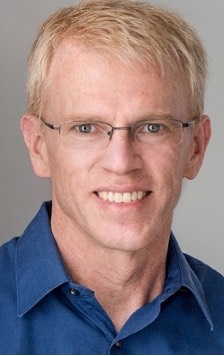
Reading Masked Faces: Emotions and Attractiveness
As we emerge from the Omicron surge of Covid-19, many of us are hoping that this is just the beginning of a lasting decline in the number and seriousness of COVID cases. But even as we get our hopes up, the experiences we’ve all had over the last couple of years have left their mark. We know more deeply than ever that the unexpected can happen. COVID has brought about all kinds of unexpected changes, both large and small, that have affected our day-to-day lives and shaped behaviors and attitudes.
One of the many things we’ve had to adjust to during COVID is the use of facial masks. In some parts of the world, such as Japan, mask-wearing was relatively common prior to the pandemic. People who were sick with a cold or the flu wore masks as a way of reducing the likelihood of transmitting their illness, out of consideration for others. However, in many parts of the world mask-wearing in public settings was unusual until the onset of the pandemic. At this point, most of us have been exposed to people wearing masks in a wide variety of contexts, including at the grocery store, in classrooms, and on the job. Not surprisingly, researchers have begun to examine some of the effects of facial masks on emotion perception, judgment of personality traits, and perceptions of attractiveness.
Do masks hinder our ability to read emotions?
Recent studies have shown that our ability to perceive others’ facial emotion displays are diminished significantly by facial masks. For example, Pazhoohi, Forby, and Kingstone (2021) found that emotion perception was affected by mask-wearing in multiple ways. They presented participants with a set of faces expressing a variety of emotions with no facial masks and the same faces with masks superimposed. They found that participants’ ability to accurately detect emotions was significantly hindered when viewing masked faces, and they also rated emotional intensity to be lower for masked faces. Interestingly, they also found that participants’ confidence in their emotion ratings decreased for masked faces, and this was true for participants who were considered low, as well as those considered high, on the autism spectrum. It may also be the case, though, that some emotions are less easily discernable than others due to mask-wearing. There is some evidence, for example, that while ratings of masked faces exhibiting happiness, anger, and sadness are less accurate, accuracy in ratings of surprised faces is not diminished (Parada-Fernandez, Herrero-Fernandez, Jorge, & Comensaña, 2021). There are numerous reasons why emotion recognition generally, and the recognition of specific emotions, might be affected by mask-wearing. Particular emotions may be more or less affected by mask-wearing because their emotional displays differentially involve the mouth and the eyes. Because surprise can be communicated quite effectively primarily through widened eyes and raised eyebrows, this may make surprise a more easily discerned emotion on a masked face.
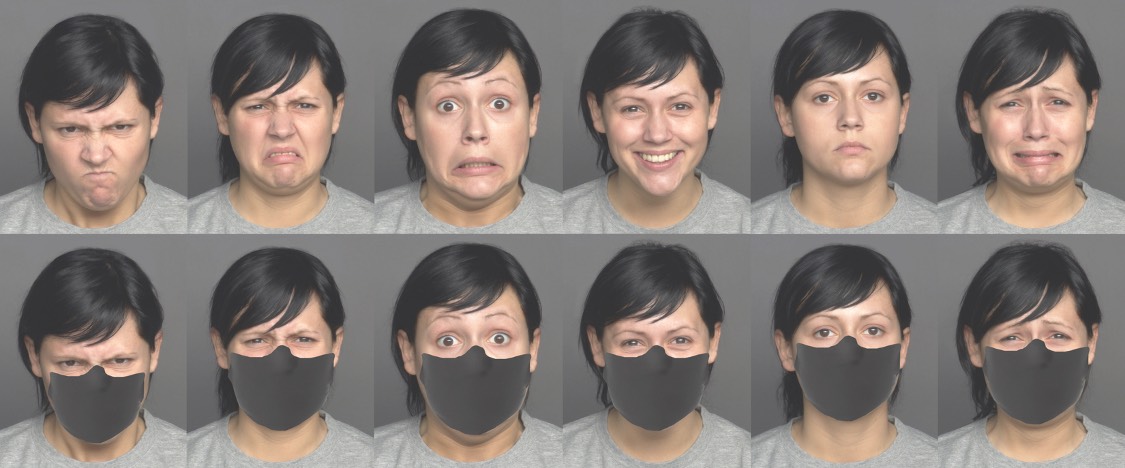
Picture from Pazhoohi, Forby, & Kingstone, 2021
What makes it hard to read emotions on masked faces?
One hypothesis about what leads to less accuracy in emotion recognition has to do with facial mimicry. Mimicking emotional displays can provide us with information about what another person is feeling and, if masks reduce our tendency to engage in mimicry (because we can’t see the entirety of a person’s face) then our ability to know what they are feeling may be limited. A recent study examined whether masks interfere with mimicry. While most research on the effects of masks on emotion perception exposes participants to photographs of masked and unmasked faces, Kastendieck, Zillmer, and Hess (2021) had participants watch videos of masked and unmasked people displaying sadness and happiness. Video can capture a shift in emotional response and more accurately reflects the way we witness emotional displays in everyday life. While they were viewing the videos, participants’ own facial responses were being recorded. The findings showed that participant mimicry was significantly less likely to occur for happiness. Participants were less likely to mirror the smiles of masked faces, both at the onset of the smiles and at the full height of the smiles. Facial mimicry was not similarly affected by mask-wearing in response to sad faces. One thing to keep in mind, as well, is that practice may go a long way to getting better at reading masked faces. The more exposure people have to masked faces, the better they are at perceiving emotions in people who are wearing a mask (Barrick, Thornton, & Tamir, 2021). Barrick et al. tested people at the beginning of the pandemic and again several months later and found that their participants paid greater attention to mask-wearers’ eyes over time. They also found that the more time they spent interacting with others, the better they became at reading emotions in masked faces.
Are masked faces more attractive?
Finally, if you’re wondering whether mask-wearing can affect our perceptions of others’ attractiveness, the answer is yes. Interestingly, people’s perceptions of mask-wearers’ attractiveness seems to have changed over time. A Japanese study conducted prior to COVID found that masked faces were considered less attractive than the same faces viewed unmasked (Miyazaki & Kawahara, 2016), perhaps because masks were associated with illness. However, more recent data collected in Japan found the opposite; masked faces were seen as relatively healthy and more attractive (Kamatami, Ito, Miyazaki, & Kawahara, 2021). Other studies reveal similar findings. In a British study, masked faces were found to be more attractive than unmasked faces, and this was the case whether faces were judged high or low in attractiveness in their unmasked state (Hies and Lewis, 2022). Mask-wearers have also been rated as more trustworthy and approachable, in addition to being seen as more attractive (Lau, 2021; Oldmeadow & Koch, 2021). In part, the apparent shift in attitudes across the globe may be due to increased familiarity of masked faces as well as our adaptability in dealing with changes brought about by COVID. Facial masks became part of our everyday lives as the pandemic unfolded. Dudarev, Manaligod, Enns, and Todd (2022) found that the positive appraisal of masks was associated with the length of time, and the frequency with which, people themselves had been wearing masks. Nonetheless, who would have guessed back in the beginning of the pandemic that we’d not only adjust to seeing people in masks, but also think that their appearance is enhanced when they wear one?
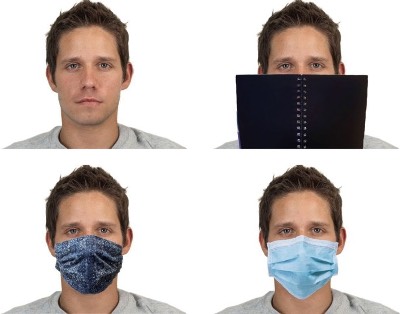
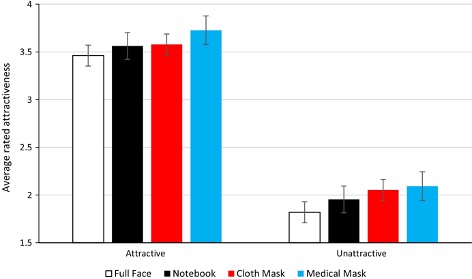
Picture from Hies & Lewis, 2022
References
Barrick, E. M., Thornton, M. A., & Tamir, D. I. (2021). Mask exposure during COVID-19 changes emotional face processing. PLoS ONE, 16(10): e0258470. https://doi.org/10.1371/journal.pone.e0258470.
Dudarev, V., Manaligod, M. G. M., Enns, J. T., 7 Todd, R, M. (2022). In the hands of the beholder: Wearing a COVID-19 mask is associated with its attractiveness. Quarterly Journal of Experimental Psychology, 75(4), 598-616.
Hies, O., & Lewis, M. B. (2022). Beyond the beauty of occlusion: Medical masks increase facial attractiveness more than other face coverings. Cognitive Research: Principles and Implications, 7(1), 1-6.
Kamatami, M., Ito, M., Miyazaki, Y., Kawahara, J. I. (2021). Effects of masks worn to protect against COVID-19 on the perception of facial attractiveness. i-Perception, 12(3). https://doi.org/10.1177/20416695211027920
Kastendieck , T., Zillmer, S. , & Hess, U. (2021). (Un)mask yourself! Effects of face masks on facial mimicry and emotion perception during the COVID-19 pandemic. Cognition and Emotion, 36, 59-69.
Lau, W. K. (2021). Face masks bolsters the characteristics from looking at a face even when facial expressions are impaired. Frontiers in Psychology, 12: 704916. https://doi.org/10.3389/fpsyg.2021.704916
Oldmeadow, J. A. , & Koch, C. (2021). Effects of facemasks on person perception. Perception, 50(10), 876-889.
Parada-Fernandez, P., Herrero-Fernande, D. Jorge, R., & Comesaña, P. (2021). Wearing mask hinders emotion recognition, but enhances perception of attractiveness. Personality and Individual Differences, 184, 1-5.
Pazhoohi, F. Forby, L., & Kingstone, A. (2021). Facial masks affect emotion recognition in the general population and individuals with autistic traits. Plos One, 16(9): e0257740.
Connecting students to older adults
As mentioned by Professor Michael Wolfe, there are many high-impact experiential learning and practices going on in our department. For example, students from the Perspectives on Aging course have engaged with older adults in one-on-one co-mentoring activities throughout the Fall 2021 semester. Given how much this project was enjoyed by both older adults and students, we thought some of you might enjoy hearing about it and maybe even getting involved in similar kinds of intergenerational interactions in the future. First, here’s a little background about the project. It started with the Grand Connections Program.
A little history of the Grand Connections program
At the 2020 Annual Art and Science of Aging Conference, a student research poster titled “Closing the Generational Gap” presented by Gabrielle Poeder caught the eye of an AARP volunteer, John Ziemann. He was so interested in the poster, especially the mentoring program proposed by the student, that he reached out to her after the conference about the possibility of making the proposal a reality. Unfortunately, the pandemic came shortly after and many things, including this program, were put on hold. However, in the summer of 2021, John could not wait any longer and he gathered together the Associate State Director from AARP and several GVSU faculty from the aging conference organizing committee. The task was to figure out how to work with ideas proposed in the poster and develop an intergenerational program to create opportunities for older and young adults to share their life experiences and knowledge, and to enrich their relationships, with each other. This small group of like-minded people, all passionate about bridging the gap between generations, met throughout the summer and led to the birth “Grand Connections,” an intergenerational integration/mentoring program. After going through the process of formally establishing a program in partnership with AARP, recruitment of older adults began at the beginning of the Fall semester of 2021. The initial recruitment of older adults was carried out by AARP.
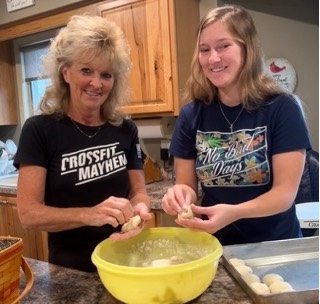
Piloting the Grand Connections Program:
Professor Jing Chen volunteered to pilot this program in her Perspectives on Aging class and her students were the first wave of the participants on younger generation side. There were 11 older adults signed up the Grand Connections program by the middle of September and Professor Chen matched each of them to one or two students based on their interests and preferences. The rest of the 46 students had an older relative or friend as their partners. Each pair was asked to engage in mentoring activities on three separate occasions and reflect their experiences in a journal entry after each interaction. They were encouraged to be creative and had the freedom to choose activities that were most meaningful to them but with one clear requirement: Each partner had to teach the other something.
What was done in the co-mentoring project?
The 46 students and their partners, in their three separate meetings, engaged in a wide array of interesting activities. Here is a glimpse into what they did.
Many older adults taught the students something:
- Making a family recipe (very popular! Some students finally learned how to make a Thanksgiving dish they had eaten their whole lives but had no idea how to make.)
- Knitting, crocheting, altering clothes, sewing (e.g., one grandma packed up her sewing machine and portable ironing board, and drove a long distance to teach her granddaughter how to make circular coasters.)
- Fishing, gardening, weeding, making dream catchers, how to insulate a window for winter
- Writing an essay and poem (one mentor from the Grand Connections program is a writer)
Students taught their partners things as well:
- Using technology (e.g., smartphone use, setting up e-mail and social media accounts, streaming movies, voice text, storing photos, downloading games, ordering things online)
- Things that they have learned from school (e.g.,research on exercise, stress, generativity and aging, mental illness)
- How to play piano
- Lacrosse, rock climbing, chair yoga
- Current lingo (e.g., student taught his writer partner this because she loves words)
- Make friendship bracelets
- Typing
They did things together:
- Apple picking, cutting a Christmas tree, delivering food and clothes for homeless people
- Building furniture such as a shelf
- Attending a wine and paint class (something neither of them had done before)
- Spending a tech-free day together (a very unique and rare experience for the student)
- Told family stories
- Discussed books they read or movies they watched together
They shared views or made the get-together special:
Some students reached out to their partners to get their insights on how to handle the tough times that they were going through, such as loss of a loved one or juggling different priorities. A number of pairs used the time to discuss issues that concern them the most. The one-on-one setting made it easier to truly hear what the other was saying, even on contentious topics such as LGBT issues, religion, and the current political divide. It also allowed the two generations to share views on things like traveling, work ethics, patience, and perceptions of aging, and helped them understand each other’s perspectives better. Some students had really creative ideas to make their meetings a memorable experience for both of them. One student gave her partner a make-over and took some glamorous pictures to make her feel special as she knew that her partner was the person who always did “things for other people and taking pictures of everyone else, so she has no pictures of herself”.
What did the older adults and students think about the project?
The feedback about the project was overwhelmingly positive. Here are what they have said about the project.
Some older adults said:
- “Special treat”
- “Urge you to continue the project”
- “We have talked about keeping in touch. I feel like I have a new friend and helped her see that a 70-year-old and 20-year-old can have fun and accomplish things together. We are hoping to connect again over the holidays. This has been such an enjoyable experience. Thank you so much for this opportunity! The only suggestion I have is to never stop doing this!!”
- “I think that it has been beneficial for the both of us and should be continued”.
Students wrote in their journal:
- Before this class, I had always seen my grandma as just that-- my grandma. She is someone who cooks and bakes for me, gives me warm hugs, and is always down to play a game of scrabble. I enjoyed this project because it allowed me to see her past that label and more as an individual person. I think connecting with her like this was good for the both of us, because it taught us about not only each other, but ourselves.
- This project is useful because it really humanizes both participants, the younger and the older, and helps establish common ground between them. I think the project should be continued on for semesters to come as it was a very educational, fun experience.
- Writing the journal makes me realize how much we actually learn from each other. I appreciate that he offers both specific and general life advice and it has helped shape me into who I am.
- All in all, it was a joyous experience and I am very glad I did it. The three hours flew by and I walked away with motivation and inspiration to become much better than I currently am.
What have we learned from this project?
- Students spent more time than expected on this project and were quite engaged. Many students felt a sense of pride and autonomy that they were able to teach their elderly partners something.
- Activities were very thoughtful and meaningful (each partner took the role of a mentor seriously as it was a co-mentoring project)
- Many pairs engaged in activities that were quite thematic across the three occasions and showed continuity across multiple interactions (e.g., discussed patience during the first meeting and practiced in subsequent occasions)
- There were many thoughtful reflections in the journal entries and some tied their experiences to what they learned in lectures.
- Benefits of the interactions are truly mutual. Their one-on-one meetings have provided the time and space for them to learn something new about each other. These are rare opportunities that allow the younger and older generations to connect. It has deepened existing relationships and built new friendships. Many of them gained new insights about the older generation as well as themselves.
What’s next?
The positive outcomes from this pilot project of the Grand Connections program have affirmed our commitment to fully develop this program for older adults and students to make connections and benefit from their interactions. A number of research studies have showed that such positive, individualized, and collaborative interactions can change young adults’ attitudes towards aging and improve older adults’ health and psychological well-being. Right now, we are working on establishing a permanent website to recruit mentors for students and also a mechanism to enroll students across campus to be part of the Grand Connections program. So please stay tuned! We may reach out to Laker Alumni in the near future!
Featuring the Panelists from the Last Career Path Panel Discussion
Last year we invited three alumni, Rachel Jenkin, Jennifer Nyland, and Andres J. Ortiz-Estevez, to discuss career issues with our current students. The event was held virtually as most of the classes were online at the time and the campus was largely empty due to the pandemic. Despite being virtual, many students attended, and the panelists shared their own education and career experiences with the students and answered students’ questions. Prior to the panel discussion, we asked the panelists to think about several questions regarding their career paths and current positions before participating in the panel. Here are some highlights from their written responses, most of which they also spoke about in the panel discussion.
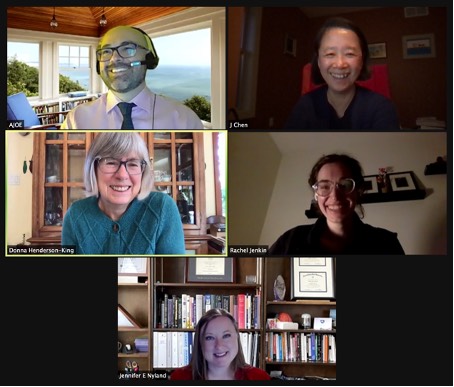
Andres J. Ortiz-Estevez:
Graduated in 2011 with a major in Psychology and minor in Sociology.
Andres described his education and career path:
Before attending GVSU, I had the opportunity to study at medical school for approximately 6 years in Colombia, South America where I was born and raised. After reconsidering my passion and career opportunities I determined that it was not my ideal career path to follow. During my education at GVSU, I intended to direct my studies towards the clinical aspect of psychology, in particular, the aspect of human behaviors and the individual/group challenges humans face that can affect their well-being.
After my graduation at GVSU, I wanted to be able to work directly in the mental health field, and was offered an opportunity in Flint, Michigan with an organization called New Passages. This organization eventually merged with Hope Network within the case management department, providing direct services to individuals with severe mental illness and co-occurring disorders. After 5 years, different visa and residence statuses, getting married and experiencing diverse opportunities within the same department (case manager, lead case manager and assistant line manager), we decided to move back to the Grand Rapids area where I currently work for Kent County Community Mental Health (Network 180) as a clinical case manager.
In his current position Andres engages in a variety of duties:
- As a case manager, works directly with individuals with severe mental illness and co-occurring disorders
- Links consumers with the needed resources that will empower them in working with their individual challenges as they pursue recovery
- Manages a full case load of consumers (currently 90) with severe mental illness, many of whom also have a co-occurring disorder: monitoring their needs, completing assessments for higher levels of care, linking them with resources, advocating for utilization of supports (health care and resources) as well as coordinating with agencies that can also provide assistance with their recovery needs
- Deals with the main challenge of navigating the limited resources available to directly benefit consumers
Andres spoke to experiences at GVSU that had a major impact on his career:
During my experience at GVSU, I had the opportunity to participate in several organizations around campus. Along with my academic responsibilities, I was also involved with the GVSU housing department as an RA/Multicultural Assistant. I also worked at the Padnos International Center helping students expand their horizons with study abroad opportunities. I participated in the International Student Organization which allowed me to create awareness about diverse international cultures around campus. One of the biggest impacts I had was to guide students in navigating available resources which would allow them to expand their cultural knowledge while interacting with students from different backgrounds.
His advice for students who are currently contemplating their future careers:
My main advice is to focus your studies and classes around your main interest and make each one applicable to your future career. If you are still undecided in a field, take the opportunity to try new things, and explore as much as you can afford to do so. Reach out to teachers or students who have information available about new subjects so you are better able to have an idea of what to expect. If you have an opportunity to intern or complete a practicum, both are extremely valuable to have a better idea of your future career path.
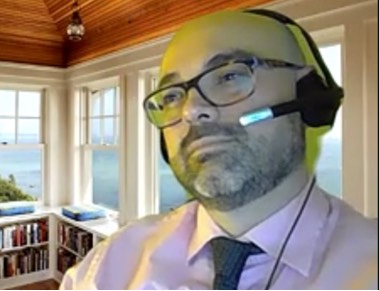
Jennifer Nyland:
Graduated in 2006 with a BS, majors in Psychology and Biomedical Sciences with a Chemistry minor.
Jennifer described her education and career path:
I knew I wanted a career in research, so I went straight from undergrad to a PhD program in Neuroscience at Penn State College of Medicine in Hershey, PA. My doctoral studies focused on animal models of reward, incorporating neurochemical, anatomical, and behavioral techniques. My work uncovered a thalamic nucleus responsible for the devaluation of naturally rewarding stimuli (food, family, sex) by drugs of abuse.
Upon completion of my PhD, I received a postdoctoral fellowship from the National Academies of Sciences to conduct preclinical pain research at the US Army Institute of Surgical Research in San Antonio, TX. I independently established an applied pain research laboratory and was shortly thereafter promoted to Staff Scientist, which allowed me to expand my program to include clinical and human-subjects research.
I was later recruited as a Principal Investigator by the Walter Reed Army Institute of Research – Medical Directorate West in Tacoma, WA to lead a team of behavioral health researchers. Our goal was to characterize the stressors facing military trainees, identify potential mitigating factors, and present actionable recommendations to leadership.
After leaving military research, my clinical research skills were further developed as a Staff Scientist at the Fred Hutchinson Cancer Research Center in Seattle, WA. I served as the Senior Project Manager for multi-center clinical studies focused on improving outcomes of patients with acute myeloid leukemia.
In 2019, I was recruited back to Penn State College of Medicine as an Assistant Professor in Neural and Behavioral Sciences. My research program focuses on the intersection of pain and addiction and incorporates preclinical animal models and clinical research.
My career path has allowed me to travel and to live in different parts of the country, which has allowed me to make friends and develop professional connections nationwide.
About the professional duties of her current position, Jennifer mentioned the following:
- Requires specific training and research expertise and reliance on ability to network and maintain professional relationships
- Teaches medical and graduate students, summer scholars
- Conducts research (including grant-writing, reading relevant literature, analyzing data, writing and conducting experiments)
- Assistant Director for Pain Studies for the Penn State Addiction Center for Translation
- Serves on Equity Advisory Committee for College of Medicine
- Serves on Institutional Review Board for research involving human subjects
Regarding an academic career, she added:
Pursuing a research career in academia is challenging. The competition for funding is intense, so you have to have a thick skin. Additionally, after going through all the work of getting a PhD, there are limited available positions. This has introduced what is called the “Next Gen PhD”, where following in the footsteps of your academic professors is not really the norm. Newly minted PhDs are taking jobs in industry, government, biotech startups, publishing companies, and the list goes on. Therefore, I consider myself extremely lucky to have a position in a R1 academic research institution.
About how experiences at GVSU shaped her career interests, she said:
I participated in a few different research experiences while at GVSU. I worked with Dr. Robert Smart for a year doing organic chemistry research and then was accepted into the McNair Scholars Program. As a McNair scholar, I worked with Dr. Lawrence Burns with a project that focused on perfectionism. These experiences sparked my interest in research.
Jennifer also had advice for current students:
Network, network, network. Make connections and don’t forget to follow up with them periodically (i.e. not just when you need something). In my experience, anytime a good position is created, the person creating it likely already has someone in mind. Be that someone.
I wish I knew as a student that the best part of my career path would be taking unexpected turns and that it’s okay if your career path seems to veer off course. It’s impossible to plan for what you don’t know exists. I see now that taking risks and trying new things is what makes the career path, well, a path. Looking back, I learned more from the mistakes and the failures than when everything would turn out as planned.

Rachel Jenkin:
Graduated in 2019 with a major in Psychology and minors in Criminal Justice and Philosophy
Rachel’s career path:
- After graduation, served as a bartender while looking for full-time work.
- Three months later, accepted a position as a research assistant studying schizophrenia at a local non-profit health center (Cherry Health for those familiar with Grand Rapids). Worked for 9 months before furloughed due to the pandemic.
- After some serious thinking, decided to pursue higher education law and found the current position, working at Grand Rapids Community College as a College Success Coach, helping motivate the first-generation and low-income students to stay in school and navigate the path of higher education and trade school options.
Main responsibilities involved in Rachel’s current position:
- Has a caseload of a little over 50 first-generation and/or low-income students; serves as their guide while navigating college
- Meets with students regularly (varying greatly in frequency dependent on student needs and responsiveness)
- Teaches workshops on basic college skills (e.g., time management and note-taking)
- Helps students plan for post-college life
- Maintains flexibility regarding day-to-day variations of workload and activities
- Creates additional programming efforts and often meet with coaches who work at other community colleges in the state to learn from each other
- The position is unique because it is grant-funded through an AmeriCorps program working with Michigan College Access Network
Rachel reflected on what contributed to getting her current position and what qualities are important:
My college experience was the largest contributor to my getting this job. I come from a family that didn’t have the means to support me going to college, and it was a struggle trying to stay afloat financially and find that external support. This experience has been crucial in being relatable to students. My own journey of funding my academic experience on my own, and working my way up to become Student Body President has helped to inspire students to keep moving forward even when the going gets tough.
I also think that empathy and active listening are key in my position. I often find a lot of my meetings with students get personal and I learn about their difficulties and home lives. I’ve learned to take those experiences that students share with me and put them into perspective as to why they may be struggling, while simultaneously empowering them to work on improving themselves. Both the challenges and the rewards are developing relationships with students. It has been amazing to see students grow and evolve and learn who they are over the time that I’ve worked with them.
Beyond the role of being a student, self-growth is a lifelong journey in my eyes. Helping someone realize that early on can be a huge push in momentum for them to work towards what their passionate about and try to find meaning for themselves. That being said, developing authentic and genuine connections is a skill and a skill that takes time. It doesn’t happen naturally with most people, and at first many students don’t understand my role. That has certainly been an obstacle to overcome, especially with everything being virtual with COVID. Nevertheless, I feel that I have grown in learning to ask powerful questions of students and utilizing the art of active listening to help students find the answers that they need.
Rachel reflected on how her experiences at GVSU affected her career choices:
My work on Student Senate was my biggest contributor to learning about who I am and what I am passionate about. During my time on Student Senate, I worked to create a sexual assault survivors group therapy, a safety walk which resulted in more lighting and security patrol on campus, the first County Commissioners meeting on campus to foster a stronger community, I created the first student speaker at graduation position and was the first student to speak, and I worked to create a student seat on the board of trustees. These projects taught me a TON about how to be a leader, ask for change, organize events, manage conflict, understand the politics in higher education, understand policy and legislation about education, and much more.
During my time in undergrad, I was pretty open to my mentors (often administrators who I met with through my work on Student Senate) and professors about not knowing what I wanted to do. This vulnerability was pivotal in opening myself up to ask for help and learn from those around me. Because I was unsure and shared that, I was put in contact with folks who held positions that I might want one day, and I got to learn from a lot of informational interviews.
Psi Chi was another organization that helped me understand the depths of what a psychology degree can do. I was vice president during my junior year, and we worked to bring professionals to campus to teach psychology students about what they could do with their degree. From an expert witness to a psychoanalyst, there was a lot to learn from, and it was all very fun.
We asked Rachel what advices she can give to the current students when thinking of their careers. She said:
Regardless of major, I think we should be thinking about the jobs we want in a little more abstract sense. Less about the title and more about, do you want to have creative power, a big team or small, traveling, room for growth, etc. These were questions that I didn’t ask myself about my first job as a research assistant, and after I left, I learned that maybe if I would have asked myself those questions early on, I would have been able to start a position that I enjoyed much earlier.
While grad school is important, a lot of folks say you have to go onto grad school if you get a degree in psychology and that isn’t necessarily true. While that may be true for some of the typical jobs that people think about in the field of mental health (counselor, psychiatrist, etc.), there are a lot of jobs where that isn’t a requirement, and I challenge you to find those jobs and get some real-world experience before considering grad school. Many employers (GRCC included) will do tuition reimbursement if you decide to go back to school while employed with them contingent on the degree that you’re seeking. No need to put yourself in debt early on when you aren’t 100% sure continuing your education is what you want or what you need.
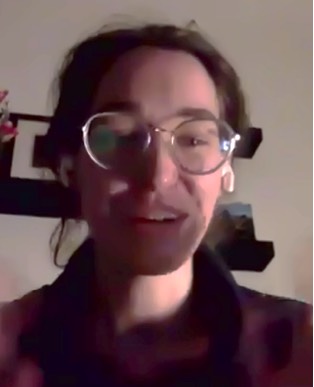
Sharing Your Advice
If you have helpful advice to give to our current students, please send a note to us by clicking here. We hope to share the collective wisdom with our current students.
